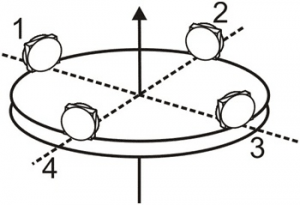The north finder is a kind of compass, which is used to find the true north direction value of a certain location. Gyro north finder, also known as gyro compass, is an inertial measurement system that uses the principle of gyro to determine the projection direction of the earth’s rotation rate on the local horizontal plane (ie true north). Its north-seeking process requires no external reference.
In addition to being restricted by high latitudes, its north-seeking measurement is not affected by weather, day and night time, geomagnetic field, and site visibility conditions. The gyro north finder is a kind of precision inertial measurement instrument, usually used to provide azimuth reference for artillery, surface-to-surface missiles and ground radars and other mobile weapon systems. Such as Ericco’s ER-FNS-02 High Precision FOG North Seeker (0.02°-0.1°) is mainly used in static initial alignment of missile launch, weapon targeting and direction control of radar, antenna and armored vehicle, also can be used for coal mining, oil drilling, tunnel construction and geodesy.
According to the type of gyroscope used, the gyroscope north finder can be divided into the following three types:
◆ A north finder with a two-degree-of-freedom gyroscope as the earth’s rotation sensor (such as a suspended pendulum gyro north finder)
◆ North finder using single-axis rate gyro as a sensor (such as strap-down gyro north finder)
◆ Platform North Seeking System
The gyro north finder is extremely sensitive to environmental vibration interference (especially low-frequency vibration interference). According to the usage environment, gyro north finder can be divided into three types: ground-mounted high-precision north finder, vehicle-mounted gyro north finder and ship moving base gyro north finder.
Ground-mounted north finder: Ericco’s ER-FNS-03 FOG gyro North Finder adopts closed-loop fiber optic gyroscope as the core component. It can provide the carrier with true north azimuth angle. It’s widely used in coal mining, oil drilling, tunnel construction and geodesy.
Vehicle-mounted gyro north finder: Ericco’s ER-FNS-01 High Performance Dynamic FOG North Seeker (0.02°-0.5°) consists of high precision, rugged solid FOG, quartz accelerometer, data acquisition and processing unit. It can provide its true north position information when the carrier moves. At the same time, the information of motion attitude, velocity and position of the carrier can also be displayed.
The fiber optic gyroscope north finder is a high-precision inertial instrument that autonomously indicates the azimuth. It can give the angle between the carrier and the true north direction without inputting the latitude value. Using the earth rotation angular rate measured by the fiber optic gyroscope and the angle between the gyroscope and the horizontal plane measured by the accelerometer, the angle between the carrier’s baseline and the true north direction can be obtained through computer calculation. The accelerometer placed on the baseline can be Measure the attitude angle of the north finder.
The fiber optic gyroscope used in the fiber optic gyroscope north finder is a solid-state device with no rotating part, so it can withstand shock and vibration. This is something that other non-optical gyroscopes cannot do.
What is the working principle of the fiber optic gyroscope? Fiber Optic Gyroscope (FOG) is a new all-solid-state gyroscope based on the Sagnac effect. It is an inertial measurement element without mechanical rotating parts. It has the advantages of impact resistance, high sensitivity, long life, low power consumption, and reliable integration. It is an ideal inertial device in the new generation of strapdown inertial navigation system.
In north-seeking applications based on fiber optic gyroscopes, most of the methods used are FOG rotation at a fixed angle, and the angle of the relative north direction is calculated by determining the offset. In order to accurately point north, the drift of FOG must also be eliminated. Generally, a rotating platform is used as shown in Figure 1. The fiber optic gyroscope is placed on a moving base, the plane of the moving base is parallel to the horizontal plane, and the sensitive axis of the fiber optic gyroscope is parallel to the plane of the moving base. When starting to find north, the gyro is in position 1, and the sensitive axis of the gyro is parallel to the carrier. It is assumed that the angle between the initial direction of the sensitive axis of the fiber optic gyroscope and the true north direction is α. The output value of the gyro at position 1 is ω1; then the base is rotated 90°, and the output value of the gyro is measured at position 2 ω2. Turn it by 90° twice in turn and turn to positions 3 and 4 respectively to obtain angular velocities ω3 and ω4.
The heading angle can be calculated through ω1, ω2, ω3, and ω4. This method can eliminate the zero deviation of the gyro, and there is no need to know the latitude value of the measurement location. If the latitude of the measurement location is a known value, the heading angle can be obtained by measuring only two positions 1 and 3 (or 2 and 4).
North Seeker
north seeking system
north finder wikipedia
north alignment system
northfinder backpack
fibre-optic gyroscope price
interferometric fiber-optic gyroscope
fiber optic gyroscope market
fiberoptic gyroscope pdf
fiber optic gyroscope tarkov








.jpg)
